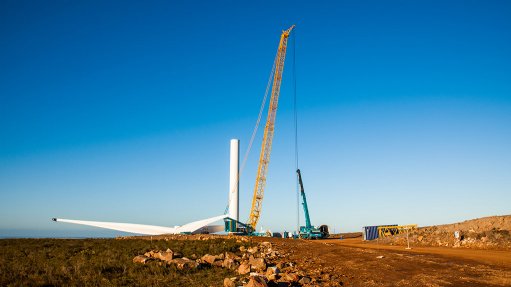
Jeffreys Bay Wind Farm
The operators of the Jeffreys Bay Wind Farm, which is one of the first wind farms arising from the South African government’s Renewable Energy Independent Power Producer Procurement Programme, on Friday announced that construction had started on the first of 60 wind turbines at the R3.17-billion 138 MW onshore wind energy project.
The construction of a single turbine by two specialist cranes working simultaneously was expected to take two to three days, depending on the weather conditions.
“This is a pivotal point in the construction of this wind farm, which is set to supply enough clean, renewable electricity to power more than 110 000 South African homes each year,” Jeffreys Bay Wind Farm GM Mark Pickering said.
The transportation of the wind turbines, from the Port of Ngqura, near Port Elizabeth, to the site, started in July, with more than 100 loads having been transported within the first month.
Loads travelled to the wind farm as single abnormal consignments with the largest blade deliveries requiring police escorts.
The wind farm operators stated that deliveries were on schedule and that the last turbines should arrive on site during January 2014.
The wind turbines were 80 m tall to allow for optimum energy production; however, when one of the blades stood vertically the turbine’s tip height would be 132 m.
The heaviest component of the turbine, at 86 t, was the nacelle, which contained the generator and gearbox. Three 49 m blades, made from fibreglass reinforced epoxy, would be connected to the rotor at ground level before being hoisted to the top of the turbine.
The Jeffreys Bay Wind Farm was expected to start supplying electricity to the national grid by mid-2014.
“Not only will the project be able to provide a significant number of homes with clean, renewable energy by harnessing the wind, it will also save millions of litres of water that would otherwise have been consumed in the production of energy,” Pickering concluded.